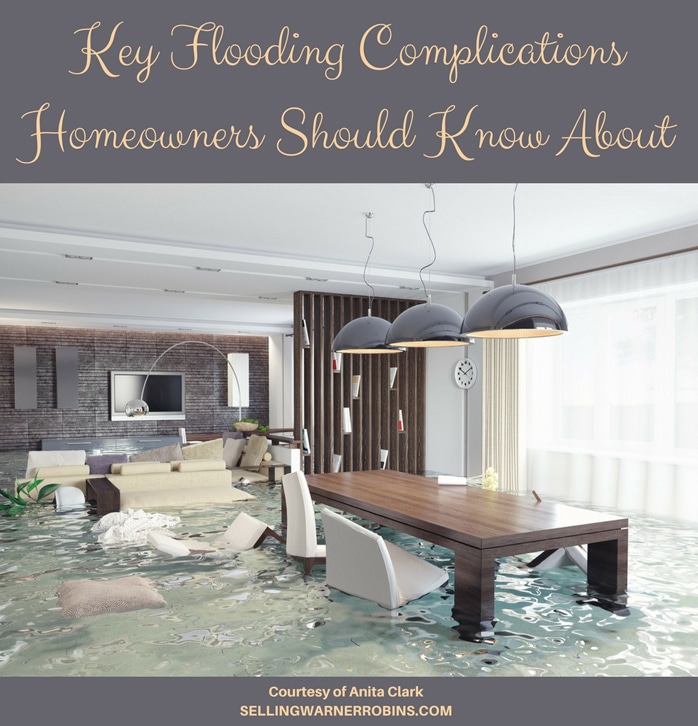Flooding Complications Homeowners Should Know About
One of the worst home related nightmares for many homeowners is having their home flood. And given recent events such as Hurricanes Harvey and Maria, flooding issues are fast becoming a possibility that many more of us have had to start planning for. We all know how devastating a flood can be. We have seen it on the news, witnessed it within our cities, and some of us have even experienced it in our own homes. It can destroy everything in its path and leave lasting scars on the building itself as well as everything around it, including insurance policies, mortgage rates and our own quality of life.
Even if a flood has not entirely filled your house, residual flood damage of any sort can cause complications that need to be handled as soon as possible, thus preventing further serious issues. We take a look below at some of the most common types of flooding issues homeowners should be aware of, how to deal with them, and most importantly, how to prevent them.

Foundation Damage
In states like Texas, flooding has caused significant damage over the last two years as rainfall has increased by an unprecedented ratio. Unfortunately, one of the most devastating effects of flooding is on your home’s foundation. The impact of the fast-moving water against your property can weaken the building’s structure and even separate it from its foundation. Remember, water that is moving at around ten miles per hour is as forceful as 270-mile-per-hour winds.
Flooding is so detrimental to your home’s foundations because it can permeate such a variety of materials. This means it can end up seeping deep into the earth, which can wreak even more havoc. Foundation pilings in certain arrangements can also move or break, causing severe foundational damage. Of course, this is all much more serious if the water contains any solid or heavy debris or chemicals.
Signs of Foundation Damage
Home foundation damage due to floods can be evident through a range of different signs throughout your house. Areas to watch out for include:
- Doors don’t close in a flush line or doors have cracked frames
- Windows do not open or shut correctly and their frames are cracked
- Walls, ceilings and floors appear to show new cracks and floor boards “pop” out of place. If the walls are not visible, the wallpaper shows tears
- Externally, bricks in the foundation show cracks and/or the foundation has visibly moved in any direction
- Your garage door does not shut properly or does not directly close above the ground
- Your floors seem to be at an angle and slope in certain directions
- There are now gaps between walls, floors and ceilings.
If you identify any of these signs, immediately consult a professional to diagnose if the property is genuinely safe to stay in. If there is obvious structural damage, your property should be evacuated with haste. If, however, damage seems to be minimal, absorb residual water with absorbent materials such as towels, but make sure to avoid all skin contact with the water while doing so. Sanitizing the affected areas while ensuring decent ventilation is the next step, as well as safely and legally disposing of any ruined carpets.
How to Prevent Foundation Damage
Preventative measures are your best friends when it comes to staving off foundational flooding damage. It can be as simple as ensuring standing water drains away from your home which is a byproduct of correctly grading your yard so it slopes away from your house. A good rule of thumb is a 6 inch grade in 10 feet. Here are several more ways to help prevent foundation damage:
- Roots can cause unseen foundation problems so plant trees and shrubs far enough away so they do not affect the home
- Install a sump pump if you have a high water table
- Put in a french drain to help with drainage
- Utilize downspouts/gutters to funnel water where you want it to go
- Fix any in-home water leaks you may have
- If you have an unfinished basement or crawl space, periodically check exposed pipes
- Waterproof your garage to include the walls
- Resolve roof leaks immediately
- Check and repair cracked caulking
- Embed the foundation (compacted soil up to 2 inches from the top of the slab)
A little preventive maintenance can go a long way and literally save you thousands of dollars. If prevention fails, early detection is a must so ensure you have a regular plan in-place to inspect your property.
Mold Damage
The aftermath of a hurricane or even a broken pipe can be a race against time to beat the mold and bacteria from spiraling out of control in the newly damp environment. Rebecca Morley, executive director at the National Center for Healthy Housing, suggests “You’ve really got 24 to 36 hours to work with” before trouble starts.
Mold can cause all sorts of complications for occupants with breathing problems such as asthma, but with enough of it, mold can even affect those who are in the best of health. Bacteria usually go hand in hand with mold, given the contaminants in flood water from sewage that, if left untreated, can cause gastrointestinal and skin infections. If you suspect mold, it is smart to call in a professional for an assessment.
Signs of Mold Damage
The typical signs of mold post-flooding will be most evident in basements, walls, carpets and wood. These microscopic organisms are already everywhere in your house, but with such increased dampness, the development into mold can be extremely quick. Visible mold growth can be seen as discoloration, which will present itself in a variety of colors including green, brown, orange or black.
There will usually be a distinct smell of earthiness or mustiness. This mold odor will be especially noticeable in basements. This is one of the hardest signs to attribute to mold, as many people are acclimatized to sneezing. However because a reaction to mold includes sneezing, congestion, or nasal drip you need to be alert to a potential mold infestation.
Cleaning up mold can be a complex process. Porous materials such as drywall or carpeting exhibiting serious mold growth must be thrown away in a safe and legal way. For items you are reluctant to discard, call a professional cleaner immediately for expert advice. For non-porous areas, use bleach and soap mixtures to wash down all mold-infected areas.
Refrigerators, freezers, washing machines and tumble dryers should also be treated for mold. These are all areas where mold spores tend to lodge themselves so be alert and take the necessary precautions and actions. When in doubt, call in a mold remediation professional to assess the situation and determine what you (or they) need to accomplish.
How to Prevent Mold Damage
Ventilation and a reduction in moisture are key ways to prevent mold damage. Humidity levels must be limited to 50 percent and under, and the use of an air conditioner, fan, or dehumidifier is the best way to manage this. Of course, if you are building a new construction home, a good rule of thumb is to utilize mold-resistant drywall (contains fiberglass not paper) or sheetrock as well as a paint that contains mold inhibitors.
It is also a good idea to keep porous materials to a minimum, such as keeping carpets out of bathrooms and basements. Another way to help prevent mold damage is to ensure all filter fans and ventilation fans are working at their optimum level. Again, a little periodical maintenance could keep you from shelling out a lot of money for repairs or remediation.

Electrical Damage
Like foundational damage, electrical damage is extremely dangerous post flood. Whatever you do, do not make any contact with the water if it has flooded your basement until after an electrician has disconnected the electrical meter from the socket. Water and electricity are a lethal combination, and a registered electrician must give the all clear that your property is safe to enter.
On immediate inspection of your property after an all clear, there are some safety considerations to be aware of:
- Carry a flashlight with you, as the electricity will likely be off. Do not be tempted to use candles or any other open flame or flammable material
- If it is not already switched off and if it is safe to do so, turn off the supply at the fuse box. Do not be tempted to switch on any electrical appliance until they have all been tested by a registered electrician
- Do not attempt to repair any appliances yourself
- Contact your service providers for gas and electricity to switch off your supply until it is safe to resume the service
- Let your insurance company know immediately what has transpired
- Do not try to touch any wires that are exposed
Many appliances that have been submerged will need replacing such as fans, fuse boxes, heaters, motors, lights, boilers, air conditioners, circuit boards and panels and switches. As tempting as it could be to hold on to them, you could be risking your safety as well as thousands of dollars by not making tough decisions to dispose of potentially faulty equipment.
Signs of Electrical Damage
If your electrician has not noticed any form of electrical damage, you may still see signs of it afterwards that develop as time goes on. Unsurprisingly, electrical damage will be most evident through electrical outlets. Some common things to look for include:
- Burning, smoke,or sparks coming from outlets
- Hot receptacles
- Electrical shocks
- Flickering bulbs
- Loose connections
- Tripped circuit breakers
- Frayed wires
Electrical damage is scary enough on its own, but when combined with water, can cause electrocution and intense fires. You should always consider the possibility of electrical damage when your home is flooded and proceed with extreme caution!
How to Prevent Electrical Damage
If you are worried about flooding, it would be in your best interest to invest in some home alterations in advance. Contracting a licensed electrician to move electric components to higher ground as well as your HVAC is a good way you could spend your money in preparation for a hurricane or something similar. You can also install GFCI outlets throughout your home or setup an uninterruptible power supply to minimize electrical damage as a result of flooding.
How can you prevent electrical damage? You cannot mitigate every possible issue but it is best achieved through regular maintenance, following established safety guidelines, and having periodic checkups on your homes electrical system. The most important consideration if you have flooding and believe your electrical system has been compromised is to think safety first.
The Need for Flood Insurance
Most homeowners do not have flood insurance. In fact, it is typically not part of your regular home insurance policy. Unless you live in a special flood hazard area or specifically get the insurance, you may be faced with handling the costs to repair/replace damages yourself.
Here are a few flood insurance facts you may not be aware of:
- You have to pay back federal disaster assistance funds (it is consider a small business loan) but any assistance you get from FEMA or your insurance company will not have to be paid back
- FEMA can force you to purchase flood insurance in accordance with the Flood Disaster Protection Act (1973) and the Flood Insurance Reform Act (1994) if you live in a special flood hazard zone
- Flood insurance is not available everywhere. You have to be located in a National Flood Insurance Program (NFIP) participating community
- NFIP does not sell insurance. You obtain it from a registered insurance agent
If you are not in a designated area, getting the insurance is optional. However, if you have the funds to afford it, having peace of mind knowing your out-of-pocket expenses will be minimal in-case of a flooding event is well worth the cost of insuring your property.
Final Flood Thoughts
Flooding is a horrific experience to go through, and it truly is a nightmare for many. What is worse is that after surviving the initial shock and genuine danger posed by the flood, the consequences of the water damage can be an even bigger blow to your home, your finances and your standard of living.
According to the Federal Emergency Management Agency (FEMA), floods are the most common and costly natural disaster in the U.S. each year.
I leave you with three important points to take away from this:
- Do not make contact or enter the house immediately after flooding due to potential structural and electrical damage
- Be vigilant in the coming weeks and months to spot any danger or damage signs mentioned above. Spend money on professionals to give you the all-clear as soon as possible
- Be ruthless. If you suspect an appliance, carpet, or wall is damaged, dispose of it as quickly as you can
If you are worried about flooding, do your best to familiarize yourself with the above tips and points so if you ever are in such a situation, you can rely on that knowledge to guide you through the most difficult times and keep yourself safe.
Additional Flood Resources
Bill Gassett: Flood Insurance Advice
FEMA: National Flood Insurance Program
FEMA: Disaster Declaration Process
If you found this article on flooding issues homeowners should be aware of helpful, please consider sharing it so others can benefit from the information too.
Homeowner Flooding Issues and Concerns
About Anita Clark Realtor
Anita Clark has written 672 posts on this blog.
by Anita Clark Anita is a residential Real Estate Agent in Warner Robins Georgia, with Coldwell Banker Access Realty (478) 953-8595, aiding buyers and sellers with all their real estate questions on her Warner Robins blog.




